Nobody talked about “It bags” when I was at secondary school in the 1990s but we all knew that status could be conferred through accessories. The rules about backpacks were particularly strict: they should be worn like a holster with both straps over the same shoulder and, above all, they had to be emblazoned with the Benetton logo.
Benetton has just turned 50 and – following years of declining sales – it is using the landmark to try to recapture its mojo. As well as releasing four capsule clothing collections, including designs from the company’s archive, it is launching a five-year “Benetton Women Empowerment Programme”, with the lofty ambition of improving female lives globally. All in all, says John Mollanger, Benetton’s chief product officer, it’s about “being ourselves again, focusing on our knitwear expertise, innovation and social commitment”.
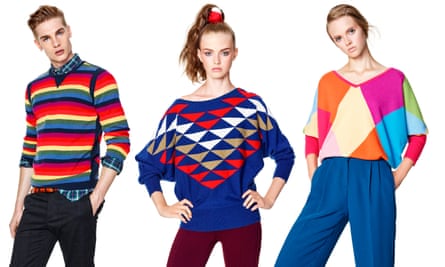
Reviving the magic won’t be easy in an age when nuanced brands – Cos’s Scandi chic; Uniqlo’s Japanese-influenced tech basics – rule the high street, with every conceivable style and price range of clothing available at the touch of a smartphone. And when £300 Michael Kors handbags are a fixture of fashion-aware teenage girls’ Instagram feeds, it’s hard to believe that an inexpensive Benetton tote could ever have been a fast track to high school canteen prestige. But in its 80s and 90s heyday, Benetton’s offering was unique: its colourful, mid-priced basics made competitors – C&A, BHS, Marks & Spencer, Next – seem grey by comparison.
Its Italianness was part of the pull: “When we started the Clothes Show, in 1986, most people didn’t know the names of British designers,” says Caryn Franklin, the former presenter and fashion editor of i-D magazine, “but they had heard of Italian designers like Cerrutti, Gucci, Valentino and Armani, partly because they had been popularised in songs. Buying into a little bit of that heritage was a huge attraction for some.” But, says Franklin, unless you were a suburban 12-year-old, Benetton’s clothes were never cutting-edge cool. The individualistic club kids of the 80s and 90s “wouldn’t have been wearing it”, she says. “Benetton was more European, utilitarian.” Former Nova fashion editor Caroline Baker, who styled many of Benetton’s campaigns in the 1980s, agrees. “It was anti-fashion. I would desperately look through every collection for the ‘fashion things’ to put into the adverts, but while all the Japanese designers were doing black, Benetton was all about colour. What they wanted was to sell clothes that were nice, colourful and lasted, which was far too middle-of-the-road for the fashion crowd.”
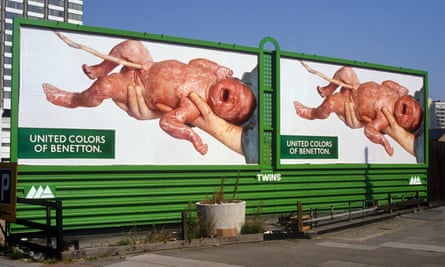
Much of the brand’s kudos came from groundbreaking advertising concieved by photographer Oliviero Toscani, who defined himself as an artist and a provocateur, not an adman. Campaigns in the 80s featured non-professional models of diverse races, “at a time when most high-street fashion imagery featured white models often caked in makeup with big Barbie-doll hair,” says Carole White, co-founder of Premier Model Management. Baker’s brief, as a stylist, was to use accessories to transform the simple clothes into costumes. “That might be Napoleon or Julius Caesar,” she says, “or Toscani would pick up on things happening in the world and would ask a black child to kiss a white child, or we would style two blond twins to look like the stereotype of a Russian person and an American.” By the 90s the campaigns were more outrageous: a bloodied, newborn baby, complete with umbilical cord; a man surrounded by his grief-stricken family, dying of Aids. “It was everything that an ad man’s perfect world wasn’t meant to be,” says fashion professor Iain R Webb, former fashion editor of Blitz.
“It tapped into a radical mood of the 80s,” says Webb, “a hugely polarised moment when so many different layers of fashion – the style magazines, Jean Paul Gaultier, Comme des Garçons – were reacting against political conservatism; provoking change and addressing the reality of our lives. There was a sense that people weren’t doing things cynically but for the right reasons.” Benetton’s aesthetic also presaged the kind of edgy, street-cast fashion photoshoots that later became commonplace in magazines such as Vice; in many ways, the industry still hasn’t caught up. “The campaigns they did in the 80s dealt with diversity in a brilliant way that I’m still calling for brands to do 30 years later,” says Franklin. White agrees: “It’s staggering how slowly change has come [with diversity in modelling]. The fashion industry is not brave; there are still magazines that are convinced that black girls do not sell.”

The company maintained that its most unsettling campaigns were inspired by a desire not just to sell jumpers, but to drive social change, but its efforts were not always well-received. “The 90s adverts never sat right with me,” says Frankin. “It was a cosy knitwear brand, and the adverts didn’t seem to be accompanied by anything; the overwhelming sense was just one of shock.” The company resuscitated this so-called “Shockvertising”, in 2011, with a campaign showing Obama kissing Hugo Chavez and the pope kissing Mohammed Ahmed al-Tayeb, the grand sheikh of al-Azhar mosque in Cairo. The latter was withdrawn after a legal challenge from the Vatican and the reams of think pieces and outraged tweets that followed demonstrated one major difference between the 90s and now. “Everyone has a voice online,” says Webb. “Perversely, that can lead to a shutting down; to people being too frightened to say anything in case it upsets or offends someone.”
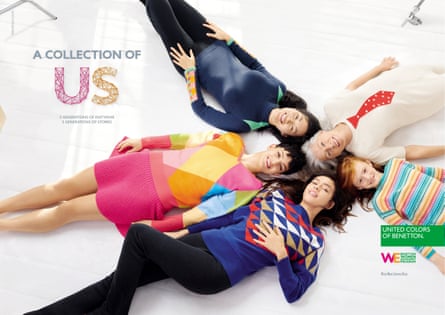
Understandably, then, Benetton’s rebooted vision for 2015 is safe. While one can imagine its 90s logo sweatshirts being worn with a knowing wink by the Wavey Garms generation, the company’s rereleased archive pieces are trend- and irony-free, including a stripy top that officially nods to grunge and Kurt Cobain but feels squeaky clean. The print ads tip a hat to diversity – one model is 72 – but are primarily brightly lit pictures of women beaming in knitwear. In an accompanying film, the models talk loosely about female empowerment; one is moved to X Factor contestant tears. Another advert is similarly lachrymose, showing fathers sobbing as their baby girls are born with the strapline: “We are Glad it’s a Girl.”
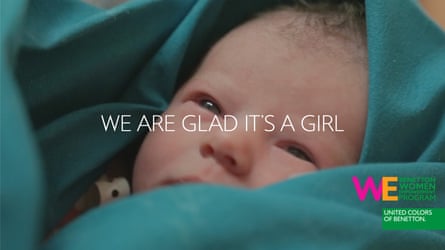
Clearly, the campaign is aiming to seamlessly knit Benetton’s jumpers with its initiative to improve women’s lives; the idea, Mollanger explained at the launch, is to move from “pointing a finger” at the world’s problems to “actively trying to improve things”. But even this seemingly blameless aim – which begins with a €2m (£1.43m) “sustainable livelihood” programme aimed to help workers in the readymade garments sector – has a deeper meaning in an age when consumers are so well-versed on the dangers of the clothing industry; Benetton was one of the companies slammed by campaigners after the Rana Plaza tragedy.
Mollanger well knows that much has changed since Benetton was king of the high street. When the company launched in the 60s, he says, “colourful knitwear was a statement in itself in a sea of grey and navy,” he says. “Today, it would be very arrogant to say that being colourful is enough. We need to clarify and amplify what we stand for.” Getting that message out will be a challenge in an era when a brand’s every move must be globally palatable and must withstand being unpicked and pored over online; when social conscience cannot be claimed through a shocking image on an advertising billboard.
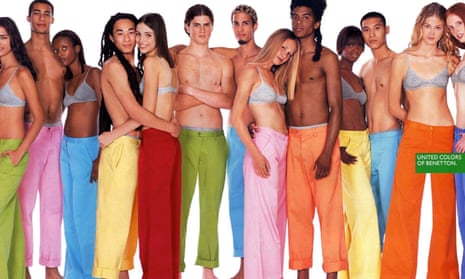
Comments (…)
Sign in or create your Guardian account to join the discussion